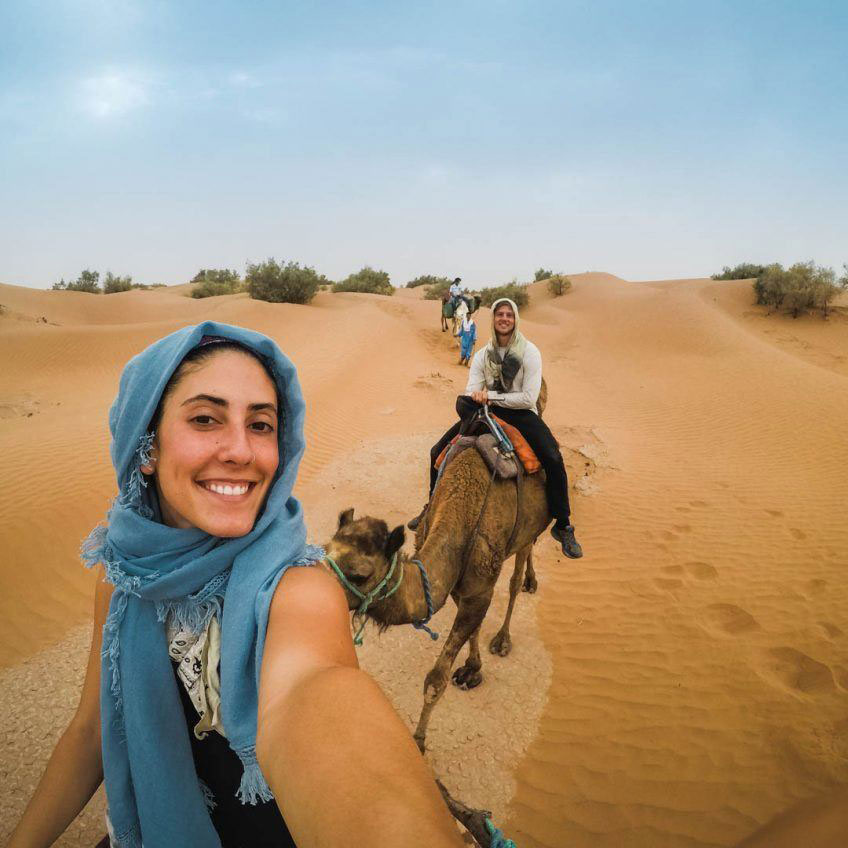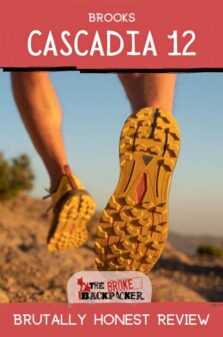If you’re a woman on the road, you need some high quality shoes for your next adventure. The Brooks Cascadia 12 bring both backpacking and trail running to the next level. Rocking some sleek new colors and an improved sole, nothing will stop you once you slip these kicks on.
In 2017, I had the opportunity to test out a pair of Brooks Cascadia 11s on the 486-mile Colorado Trail. They saw dirt, mud, river crossings, ice, and snow. But the Cascadia 11s never failed to pull it off. So I’m stoked to be testing the Cascadia 12. Brooks is known for efficient, reliable engineering.
The Brooks Cascadia 12 fit that description. And Brooks’s mission is to utilize runner feedback to continue designing the best running shoe in the world. They’re also very sensitive to paying attention to details. So when weaknesses surface, the engineering team takes them very seriously. Plus Brooks is a company that shares my values in that they’re dedicated to getting people outside, so I like supporting them.
Alright then, let’s get to this Cascadia 12 review!
Brooks Cascadia 12 Trail Runner Overview
MSRP: $130
Weight: 10.5 oz
The Brooks Cascadia 12 offers extra protection over other competing shoes. The build of the shoe is meant to take on burly terrain. Sticks/rocks/roots etc. are weak competitors for the Cascadias.
There’s extra cushion in this design to accommodate the strain of off-roading. The cushioning adapts to you so you don’t have to adapt to it.
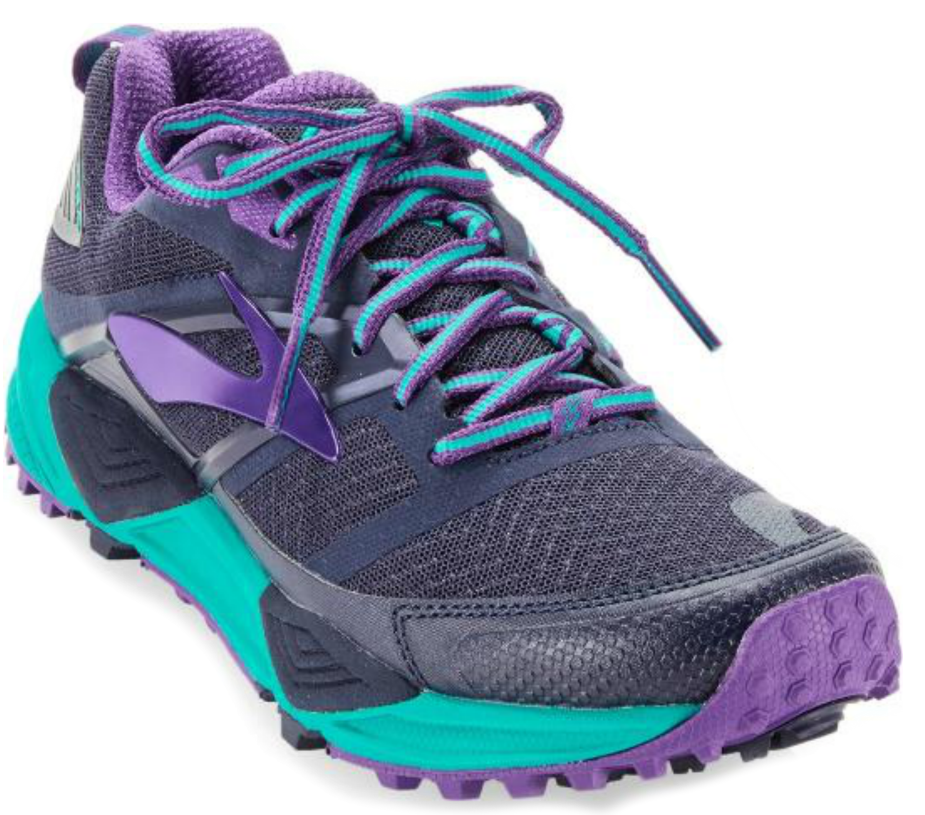
The arch design is meant to accommodate medium to high arches. There’s neutral support, and the midsole drop is 10mm.
Brooks offers free shipping and returns, as well. This makes the purchase a little less stressful if you’re working online and are afraid you’re going to drop $130 for no reason.
In addition to their policy on shipping and returns, they have a 90-day 100% satisfaction guaranteed stance. Meaning, if you don’t like your shoe for any reason at all, they’ll refund you the cost of the shoe. They back their products enough to guarantee you’ll like them.
Pros: The Brooks Cascadia 12 have a really solid, meaty tread. Traction is never an issue when you’re rocking these kicks. They offer above-average support. I have a medium to high arch. While hiking the Appalachian Trail, I wore the green superfeet to accommodate this flaw in my manufacturing.
But many of Brooks shoes come with a built in Arch, which means you don’t have to drop another $50 on insoles. It’s not that often that you can find a pair of trail runners that have both reliable tread and arch support. But the Cascadias knock it out of the park.
Cons: Brooks is such a large company that sometimes the customer service response takes a minute. But once you’re directed to the right contact, issues are resolved quickly and graciously.

REI is one of America’s biggest and most-loved outdoor gear retailers.
Now, for just $30, get a lifetime membership that entitles you to 10% OFF on most items, access to their trade-in scheme and discount rentals.
Join REI Today!Brooks Cascadia 12 Highlights
- Comfortable padding
- Cool color choices
- Stellar Tread
- Durability
- Great arch support
Other reviewers of these trail runners say:
The Cascadia 12 run just a little bit small, and the width is a little bit narrow. But the comfort is out of this world. My experience with them has been different. I think that the fit is spot on and I have no complaints with either the sizing or the width.
Why opt for a trail runner instead of a roadrunner shoe
If you’re consistently in a setting where gravel, dirt, roots and rocks litter the ground, a trail running shoe helps you maintain control over your dynamic stride. Whereas a road running shoe is designed for static motion. The tread isn’t as thick because it doesn’t need to be to maintain traction on the sidewalk.
How the Brooks Cascadia 12 stand up in questionable terrain
The general rule of thumb for a solid pair of shoes is that they should last 500 miles. They might still look pretty after that point, but the support will degrade. My experience with Cascadias (and Brooks in general) has met that criteria. And I suspect that the Brooks Cascadia 12 will pass that boundary with flying colors.
While hiking the Appalachian Trail, I pretty much stuck to a couple of different models of Merrell trail runners. Those shoes lasted me anywhere from 240 miles to about 500. I have yet to be disappointed by any pair of Brooks shoes I’ve owned. Or to receive fewer than 500 solid miles.
What’s New with these Trail Runner Shoes
Every generation of shoes brings new, fabulous changes. Brooks, as a company, places a lot of emphasis on the evolution of shoes. So what’s new with the Brooks Cascadia 12?
Let’s do a bit of a Brooks Cascadia 11 vs 12 comparison.
The New Cascadia Mesh Design:
My biggest complaint with the Cascadia 11s was that the mesh tore pretty early on, and in the same places on both shoes. While that could certainly be an insight into the way I walk, I wondered if it was actually a flaw in manufacturing. But since I got 500 miles out of the shoes, I didn’t fight it.
500 miles is generally about the life-expectancy of a pair of trail runners. And the Cascadia 11s made it that distance. The Cascadia 12, however, have a new mesh design. New advances in engineering reinforce areas where previous tearing presented itself.
Brooks Cascadia Colors:
The Cascadia 11’s most popular shoe is available in a salmon/navy/pink combo. The Brooks Cascadia 12 most popular shoe is available in a teal/black/purple combo.
How advances in tread optimize hiking:
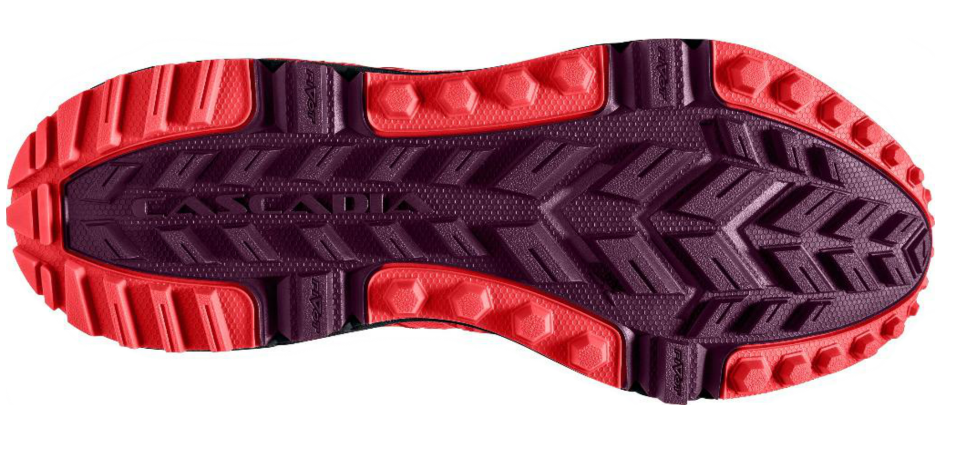
The Brooks Cascadia 11s have a lot of reinforcement on the front of the shoe, which is optimal for static motion. The Cascadia 12 have reinforcement over the whole shoe that’s optimal for dynamic motion. Meaning the Cascadia 11s are very efficient when you’re running forward consistently, while the Cascadia 12 support abrupt movements. The Cascadia 12 is more efficient than the Cascadia 11s when rock scrambling and hopping around. But the Cascadia 11s offer a good solution to continuous, straight forward motion.
Trail Running Comfort:
After a weekend of intense cardio in the backcountry, I didn’t have any hot spots or achiness in my feet at all. And arch achiness is a constant enemy of mine. I suspect this is due to the phenomenal support and efficient design of the Brooks Cascadia 12 GTX.
Weight of the Brooks Cascadia 12:
As an ultralight hiker, I’m always looking for ways to slice the strain I put on my body. Both the Cascadia 11s and 12s do a phenomenal job of offering gritty support at an efficient weight. Even while soaking wet, they’re not the heaviest shoes I’ve worn. But they also provide enough cushion and reinforcement to allow me to take on the tallest mountains in the country.
Trail Runner Ventilation:
Part of the reason why I made the choice to rock trail runners instead of meaty boots is that they dry out really quickly. For instance, while hiking the Appalachian Trail, I forded rivers on a daily basis. There were a few times when I took my shoes off, hoping that I’d make it across with bare feet.
Ultimately, I’d fall in, wasting energy and time. So, I began wearing my shoes through the crossings. The perk to wearing trail runners is that they’re generally dry within a couple of hours. While boots get wet and stay wet. The Cascadias certainly meet these criteria.

Now, you could spend a fat chunk of $$$ on the WRONG present for someone. Wrong size hiking boots, wrong fit backpack, wrong shape sleeping bag… As any adventurer will tell you, gear is a personal choice.
So give the adventurer in your life the gift of convenience: buy them an REI Co-op gift card! REI is The Broke Backpacker’s retailer of choice for ALL things outdoors, and an REI gift card is the perfect present you can buy from them. And then you won’t have to keep the receipt. 😉
Buy on REI!How to make sure your trail runners fit
In my experience, Brooks shoes are very true to size with the exception of one pair (The Launch 3 runs small). If there’s any doubt in your mind about where you fit on the running radar, go to a running store and have them watch your gait and measure your stress points.
Some shoes are designed to compensate for pronation, while others accommodate supination (under-pronation). I generally wear a half size larger in my hiking and running shoes than I do in my day-to-day shoes. This is because your feet will swell (sometimes even more significantly than a half size).
While I was hiking the Appalachian Trail, my feet grew a whole size and a half. Since then, they shrunk by a half size. But a younger version of myself was a full size smaller. Other hikers claim that growing feet is a myth. Or that growth is minimal if it happens at all. It’s important to be cognizant of what’s happening to you specifically because everyone’s experience is different.
Something to note: If you don’t go up a half size for your running shoes, you might notice some rubbing on your pinky-toe side. The toe box isn’t super wide on the Brooks Cascadia 12 women’s shoes.
Will the Brooks Cascadia 12 break your bank?
Brooks shoes aren’t cheap. But as someone who likes to walk across the country, my feet are a really important investment. Especially if I’m going to continue chasing this lifestyle. Cheaping out on shoes is a poor life choice when your feet are your most important asset.
Additionally, Brooks shoes are more expensive for a reason. Brooks invests in engineering, and the materials used for their shoes. The support, durability, and efficiency of these shoes are worth the cost.
If you’re only intending to hike a short distance once a month, investing in a shoe like the Brooks Cascadia 12 might not be completely essential. But if you’re committed to a regular life in the outdoors, I’d highly recommend a durable, supportive shoe like the Cascadia 12.
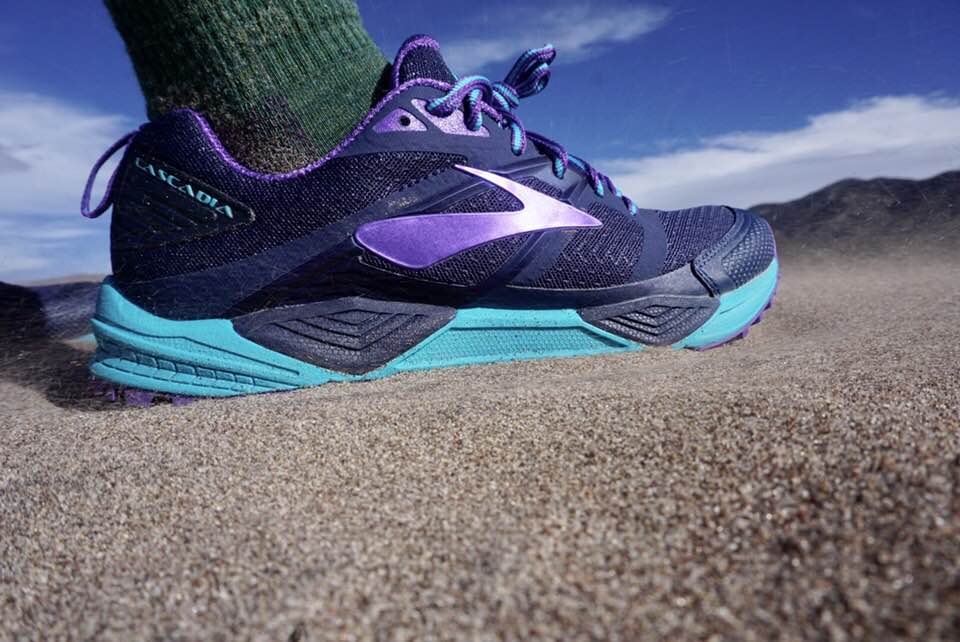
The Great Sand Dune National Park, Colorado
As someone who often struggles with arch pain, the Brooks Cascadia 12 has blown me away. While wearing Merrell trail running shoes, my arch generally starts to ache after 6-7 miles. But after a 13-mile day in the Sand Dunes, my feet were in stellar condition. I could’ve kept going without complaint.
Brooks has the reputation for building solid, supportive, long-lasting shoes. Many cross-country teams opt to buy their shoes in bulk with good reason. My experience has been just as positive.
The Cascadia 12 is really Brooks’ most solid (2018) trail running shoe. There are a handful of other trail runners that are available. But the lack of options doesn’t dissuade me from investing in the Cascadia 12, because they’re an incredibly impressive shoe.
You don’t really need tons of trail running shoes at your disposal when you have one that’s as consistent as the Cascadia. And the exciting thing about the Cascadias is that the engineering is only improving, which means that an already great shoe will only get better.
Are the Cascadia 12 right for you?
When it comes to backpacking, I try to keep my setup as light and efficient as possible without compromising efficiency. The Brooks Cascadia 12 offer some really awesome support for the weight of the shoe. They’re a logical step in the evolution of backpacking footwear. If you’re worried about ankle support, try to reduce the weight of the rest of your setup.
Something to consider: Everyone’s feet are tremendously different. While I can’t praise the Cascadia’s enough for providing me with the perfect product, I’d also like to point out that it might not be the best shoe for someone with flat feet. Or if your toes require more space in the toe box, take a look at shoes like Altras instead of Brooks.
Another great option, are the Cascadia 15 which are intended for slightly smoother terrain.
My personal experience with Brooks as a company and a running shoe provider has been exceptional. But that doesn’t mean everyone will have the same experience. Because we don’t have the same feet.

Our GREATEST Travel Secrets…
Pop your email here & get the original Broke Backpacker Bible for FREE.
Final Thoughts About the Brooks Cascadia 12
So, we’ve come to the end of our Brooks Cascadia 12 GTX review and it’s time to sum things up.
Brooks has a phenomenal collection of reliable, durable running shoes. As a company that identifies with my mission to get outdoors and maintain an active lifestyle, I like the idea of supporting their cause. And they support you back.
I’ve had great experiences with everything except for the tearing mesh in the Cascadia 11s. And it looks like the Cascadia 12 model resolves that issue.
These kicks offer an awesome option for a bunch of different types of terrain. Although they’re designed to take on a more rugged journey, I’ve used them on everything from sidewalk running to boulder hopping without issue. And Brooks stands behind their products, which makes the investment a lot less scary.
What is our final score for the Brooks Cascadia 12? We give it a rating of 4.2 out 5 stars!

I hope you found this Brooks Cascadia 12 review to be informative and helpful in your search for the right kicks.

And for transparency’s sake, please know that some of the links in our content are affiliate links. That means that if you book your accommodation, buy your gear, or sort your insurance through our link, we earn a small commission (at no extra cost to you). That said, we only link to the gear we trust and never recommend services we don’t believe are up to scratch. Again, thank you!


